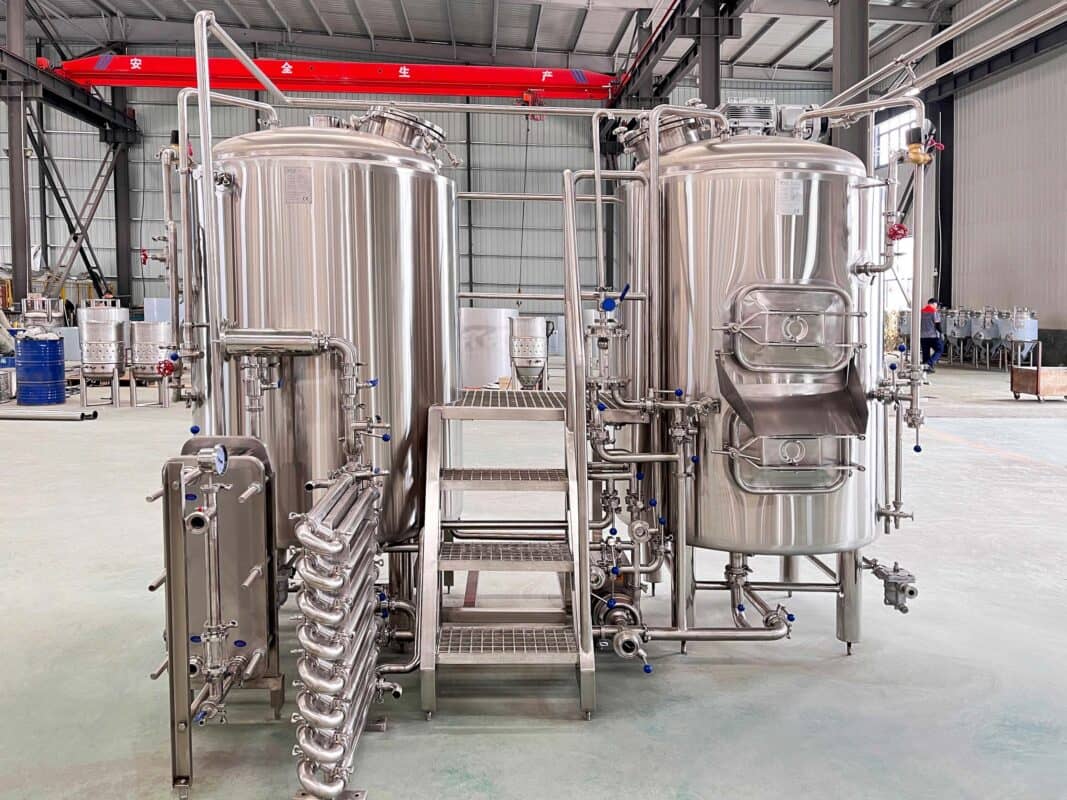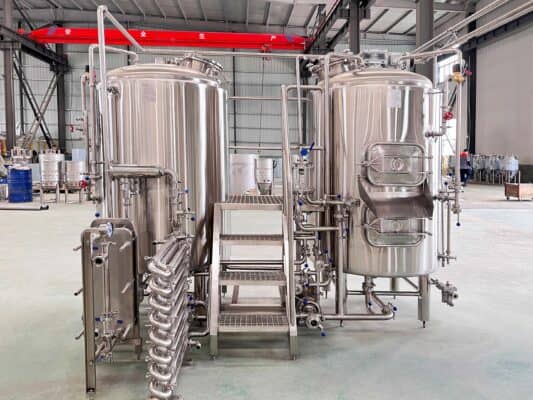Ausrüstung zum Brauen von Alkohol Für die Herstellung von Bier, Wein, Spirituosen und anderen alkoholischen Getränken sind spezielle Geräte erforderlich. Dieser Leitfaden bietet eine Zusammenfassung der wichtigsten Gerätetypen, Überlegungen zur Auswahl und Installation von Systemen und Anbietern.
Arten von Alkoholbraugeräten
| Ausrüstung | Beschreibung |
|---|---|
| Brühkessel | Beheizte Gefäße zum Maischen von Getreide und zum Kochen von Würze. Erhältlich in Edelstahl oder Kupfer. Die Größen reichen von 5 bis 20 Fässern. |
| Gärbehälter | Edelstahl- oder Kunststofftanks, die eine kontrollierte Alkoholgärung ermöglichen. Die Größe richtet sich nach dem Chargenvolumen, typischerweise 10 bis 1000 Fässer. |
| Temperaturkontrolle | Heiz- und Kühlelemente wie Glykolkühler zur Regulierung der Tanktemperaturen. |
| Rohrleitungen, Ventile, Pumpen | Hardware zum Übertragen von Flüssigkeiten, zur Regulierung des Durchflusses und zur Reinigung von Geräten. Manuell oder automatisiert. |
| Prozesskontrolle | Sensoren, Automatisierungsgeräte und Software zur Überwachung und Steuerung des Brauens. |
| Abfüll-/Konservenlinie | Hochgeschwindigkeitsmaschinen füllen/verschließen Flaschen oder Dosen. Halb- oder vollautomatisch. |
| Getreideverarbeitung | Mühlen, Förderbänder und Silos zur Lieferung und Verarbeitung von Getreide. Der Grad der Automatisierung variiert. |
Anpassungsfaktoren
Brauereien haben je nach Produktionszielen, Budgets, Personalbesetzung und Platzbeschränkungen besondere Anforderungen an die Ausrüstung. Wichtige Anpassungsfaktoren:
| Faktor | Auswahlmöglichkeiten |
|---|---|
| Größe der Charge | 5-bbl-Systeme bis hin zu großen Industriesystemen |
| Automatisierungsgrad | Manuelle Ausrüstung bis hin zu vollautomatischen Sudhäusern |
| Energieeinstellungen | Elektro-, Gas- oder Dampfheizung; Glykol vs. Direktexpansionskühlung; Automatisierungsspannung |
| Materialien | Edelstahl, Kupfer, Kunststoff – Auswirkungen auf Haltbarkeit, Wartung und Geschmack |
| Layout | Der verfügbare Platz, der Arbeitsablauf und die Ergonomie beeinflussen den Platzbedarf und die Positionierung der Geräte |
Ausrüstung zum Brauen von Alkohol Lieferanten und Kosten
Viele ANBIETER bieten den Verkauf, die Installation und die Wartung von Brauanlagen an. Die Preise variieren stark je nach Ausstattung und Anpassung.
| Unternehmen | Angebote | Preisspanne |
|---|---|---|
| Brauerei | Vollautomatische Sudhäuser | $100.000 bis $2M+ |
| JV Nordwest | Manuelle und automatisierte Systeme | $50.000 bis $750.000 |
| Amerikanische Bierausrüstung | Braukessel, Tanks, Rohrleitungen | $5.000 bis $1M |
Faktoren, die den Preis von Alkoholbrauanlagen beeinflussen
Egal, ob Sie ein Wochenend-Krieger sind, der eine kleine Charge eines experimentellen Pale Ale braut, oder ein erfahrener Brenner, der einen preisgekrönten Whiskey herstellt - es ist wichtig, die Faktoren zu verstehen, die den Preis der Ausrüstung zum Brauen von Alkohol beeinflussen. Die Kosten können stark variieren, von ein paar Dutzend Dollar für ein einfaches Homebrew-Kit bis zu Hunderttausenden (oder sogar Millionen) für professionelle Anlagen. Was unterscheidet also einen preisgünstigen Sprudler von einem Spitzengerät für die Brauerei? Schauen wir uns die wichtigsten Kostenfaktoren an:
Umfang und Ehrgeiz: Dies ist der wichtigste Punkt. Die Größe und Kapazität Ihrer Ausrüstung wirkt sich direkt auf den Preis aus. Eine Heimbrauanlage, die literweise braut, kostet natürlich weniger als eine kommerzielle Brauerei, die Fässer abfüllt. Überlegen Sie sich, was Sie brauchen: Brauen Sie zum persönlichen Vergnügen oder wollen Sie eine Massenproduktion?
Materielle Angelegenheiten: Edelstahl ist das Nonplusultra in der Welt der Brauereiausrüstung. Er ist haltbar, leicht zu reinigen und verleiht Ihren Kreationen ein Minimum an Geschmack. Im Vergleich zu Optionen wie Kunststoff oder lebensmittelechten Eimern hat er jedoch einen hohen Preis. Ein Upgrade auf Merkmale wie doppelwandige Isolierung oder Spezialmetalle kann den Preis weiter in die Höhe treiben.
Die Automatisierung summiert sich: Manuelle Systeme erfordern Muskelkraft, während automatisierte Systeme die schwere Arbeit (und das Heizen und Kühlen) übernehmen. Die Automatisierung ist zwar praktisch, hat aber ihren Preis: Funktionen wie Temperaturregelungseinheiten und programmierbare Gärzyklen treiben den Preis in die Höhe.
Marke Prestige: Etablierte Marken, die für ihre Qualität und Zuverlässigkeit bekannt sind, haben oft einen höheren Preis. Sie bieten unter Umständen bessere Garantien, eine bessere Verarbeitung und einen besseren Kundendienst, was für manche Brauereien den Aufpreis rechtfertigt. Preisgünstige Optionen von weniger bekannten Marken können jedoch ebenso effektiv sein.
Spezialisierte Stile: Die Herstellung spezieller Alkoholarten wie Sours, Kombucha oder Spirituosen erfordert oft eine besondere Ausrüstung. Schnellkochtöpfe, spezielle Fermenter und Destillationskolonnen erhöhen die Komplexität und die Kosten und bedienen einen Nischenmarkt.
Standort, Standort, Standort: Die Geografie spielt eine überraschende Rolle. Der Import von Geräten kann zusätzliche Kosten aufgrund von Versand, Steuern und Währungsschwankungen verursachen. Lokale Hersteller oder Marktplätze für gebrauchte Geräte können günstigere Optionen bieten.
Denken Sie daran, dass es eine Investition ist: Auch wenn die anfänglichen Kosten abschreckend erscheinen mögen, betrachten Sie die Brauausrüstung als eine Investition. Hochwertige Geräte können jahrelang halten und unzählige Chargen Ihrer Lieblingsgetränke produzieren. Überlegen Sie, welche Ziele Sie langfristig verfolgen, und wählen Sie eine Ausrüstung, die zu Ihrem Budget und Ihren Ambitionen passt.
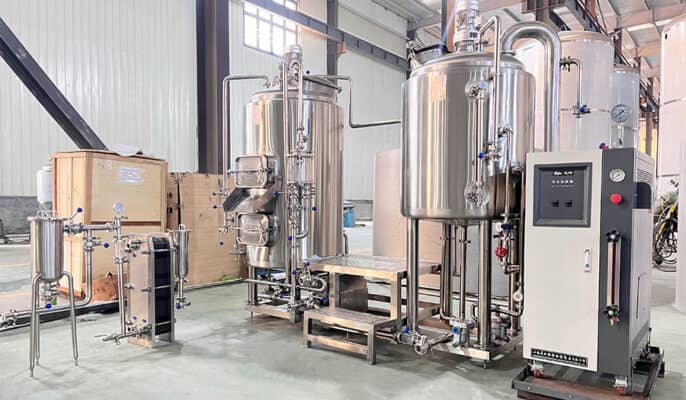
Überlegungen zu Kauf und Betrieb
Die Auswahl eines geeigneten Lieferanten und Systems erfordert die Bewertung vieler Faktoren:
| Kauffaktoren | Betriebsfaktoren |
|---|---|
| Gerätequalität, Zuverlässigkeit, Garantie | Energieeffizienz, Betriebskosten |
| Reputation und Erfahrung des Unternehmens | Wartungsanforderungen |
| Anpassungsmöglichkeiten, Flexibilität | Schulungsbedarf des Personals |
| Haushalt | Reinigungsverfahren und Chemikalien |
| Lieferzeit für Herstellung und Lieferung | Einhaltung von Vorschriften, Inspektionen |
Die Bewertungskriterien hängen von den Zielen, den Finanzen und der Risikotoleranz der einzelnen Brauereien ab. Die meisten zielen darauf ab, die Leistung innerhalb der Budgetbeschränkungen zu optimieren.
Diese Übersicht deckt die übliche Ausrüstung in Alkoholproduktionsanlagen ab. Es gibt viele Variationen und Ergänzungen, wie Destillationssysteme für Spirituosen oder Brecher für die Weinherstellung. Brauer können mit Add-ons wie Qualitätskontrolllaboren zur Prüfung des Alkoholgehalts, der Geschmacksprofile und der Qualität weitere Anpassungen vornehmen. Bei sorgfältiger Auswahl und Bedienung ermöglichen Brauanlagen eine effiziente, konsistente Alkoholproduktion mit Zielmengen und -kosten.
Auswahl der richtigen Gärtanks
Gärtanks sind eine entscheidende Komponente für die Steuerung des Alkoholproduktionsprozesses. Brauer müssen bei der Auswahl von Tanks viele Faktoren berücksichtigen:
Tankgröße
Winzige Titanen: Perfekt für neugierige Experimentatoren bieten 1-Gallonen-Krüge oder -Karaffen einen kompakten und budgetfreundlichen Einstieg. Sie sind ideal zum Testen neuer Rezepte oder zum Herstellen von Chargen in persönlicher Größe und passen gut in Küchen und Wohnungen.
Weekend Warriors: Die Vergrößerung auf 5-Gallonen-Karaffen oder -Kessel öffnet die Türen zu mehr Vielfalt und gemeinsamer Nutzung. Diese beliebte Größe richtet sich an den Gelegenheitsbrauer, der seine Kreationen gerne mit Freunden und Familie teilt, und bietet genug Volumen für mehrere Sixpacks, ohne den Raum zu überfordern.
Heimwerker-Helden: Der Schritt in den 10-Gallonen-Bereich bedeutet eine Verpflichtung gegenüber dem Handwerk. Diese Größe ermöglicht die Herstellung mehrerer kleinerer Chargen oder größerer Einzelchargen und richtet sich an diejenigen, die den Prozess ebenso genießen wie das Endprodukt. Denken Sie an wöchentliche Brausitzungen oder die Versorgung kleiner Versammlungen.
Sterne im Kleinmaßstab: Für diejenigen, die von einer Produktion im Stil einer Kleinbrauerei träumen, bieten 20-30 Gallonen Kessel und Gärbehälter einen bedeutenden Sprung. Diese Größe eignet sich für ambitionierte Brauer, die eine konstante Produktion anstreben, lokale Märkte beliefern oder größere Veranstaltungen ausrichten wollen. Denken Sie daran, dass auch der Platz- und Reinigungsbedarf zunimmt!
Jenseits der Norm: Wenn man die 30-Gallonen-Marke überschreitet, ist das ein ernstes Geschäft. Diese Anlagen, die oft modular oder stapelbar sind, richten sich an etablierte Brauer oder aufstrebende Unternehmer, die eine Produktion und einen Vertrieb in größerem Maßstab anstreben. Stellen Sie sich auf spezielle Brauräume und erhebliche Investitionen ein.
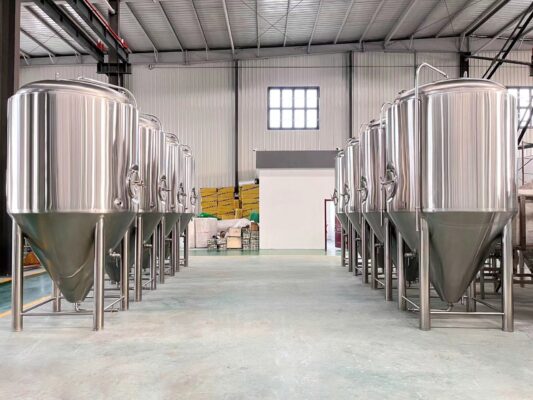
Tankmaterial
Bei der Wahl der Ausrüstung für Ihr Alkoholbrauabenteuer spielt das Tankmaterial eine entscheidende Rolle für Ihr Erlebnis. Jede Option bietet einzigartige Vor- und Nachteile, und diese zu verstehen ist der Schlüssel zu einer fundierten Entscheidung. Schauen wir uns die gängigsten Kandidaten an:
Der König der Langlebigkeit: Rostfreier Stahl
In der Welt des Bierbrauens steht Edelstahl an erster Stelle und zeichnet sich durch seine außergewöhnliche Haltbarkeit, Korrosionsbeständigkeit und einfache Reinigung aus. Er verleiht Ihren Kreationen einen minimalen Geschmack und widersteht den Strapazen der Desinfektion und Temperaturschwankungen. Seine Robustheit hat jedoch ihren Preis, weshalb er die teurere Option ist.
Budgetschonende Wahl: Plastik
Für kostenbewusste Brauer bietet Kunststoff eine erschwinglichere Alternative. Behälter und Eimer aus lebensmittelechtem Kunststoff eignen sich perfekt für kleinere Brauprojekte oder erste Experimente. Einige Kunststoffe können jedoch Chemikalien in Ihr Gebräu auslaugen und halten hohen Temperaturen möglicherweise nicht so gut stand wie Edelstahl. Außerdem sind sie anfälliger für Kratzer und Flecken.
Der traditionelle Touch: Holz
Holzfässer verleihen Ihren Kreationen einzigartige Aromen und Texturen und verleihen Ihren Gebräuen einen Hauch von Geschichte und Charakter. Eiche ist die bevorzugte Wahl für die Reifung von Spirituosen wie Whiskey und Apfelwein, während andere Hölzer wie Kirsche bestimmte Biere ergänzen können. Holz erfordert jedoch einen hohen Pflegeaufwand, ist anfällig für Lecks und kann schwierig zu reinigen sein, was es zu einer Nischenoption für engagierte Enthusiasten macht.
Der Vorteil von Glas: Klarheit und Einfachheit der Betrachtung
Für die visuelle Beobachtung und das Brauen im kleinen Maßstab bieten Glaskaraffen unbestreitbare Vorteile. Man kann den Gärungsprozess direkt beobachten, was sie ideal für Lehrzwecke oder das Experimentieren mit neuen Techniken macht. Glas ist jedoch zerbrechlich und erfordert eine vorsichtige Handhabung, weshalb es für größere Anlagen oder häufigen Gebrauch weniger geeignet ist.
Jenseits der Norm: Spezialisierte Optionen
Für bestimmte Braustile oder besondere Anforderungen können Sie auf speziellere Materialien wie Aluminium, Kupfer oder sogar Beton zurückgreifen. Jedes dieser Materialien bietet bestimmte Vorteile und Einschränkungen, die auf bestimmte Anwendungen zugeschnitten sind. Es ist von entscheidender Bedeutung, dass Sie sich über die Eignung für den von Ihnen gewählten Stil informieren.
Temperaturkontrolle
Einfache Lösungen für Gelegenheitsbrauer:
Für kleine Anlagen oder diejenigen, die mit dem Brauen beginnen, bieten einfache Methoden wie Wasserbäder oder Kühlakkus einfache, budgetfreundliche Optionen. Sie erfordern zwar mehr manuelle Eingriffe, können aber für die Aufrechterhaltung gleichmäßiger Temperaturen effektiv sein, insbesondere bei Bierstilen mit weniger strengen Anforderungen.
Einstimmen: Eintauchkühler und Heizelemente:
Diese Arbeitspferde der Temperaturkontrolle stehen in direkter Wechselwirkung mit Ihrem Braugefäß. Eintauchkühler verwenden eine in die Würze oder den Gärbehälter eingetauchte Spule, um das Gebräu effizient zu kühlen, während Heizelemente für eine präzise Temperaturkontrolle während des Maischens oder Kochens sorgen. Sie bieten mehr Kontrolle als passive Methoden, erfordern aber kompatible Geräte und einige technische Kenntnisse.
Die Automatisierung nimmt die Zügel in die Hand: Temperaturregler:
Sie wollen Ihr Spiel aufwerten? Ziehen Sie einen speziellen Temperaturregler in Betracht. Dieses handliche Gerät fungiert als das Gehirn Ihrer Anlage und überwacht und regelt die Temperatur auf der Grundlage vorprogrammierter Einstellungen. Sie werden oft mit Eintauchkühlern oder Heizelementen kombiniert, um den Prozess zu automatisieren und gleichbleibende Ergebnisse zu gewährleisten.
Der All-in-One-Ansatz: Fermentationskammern:
Die ultimative Kontrolle und Bequemlichkeit bieten Gärkammern, die die nächste Stufe erreichen. Diese isolierten Gehäuse beherbergen Ihre Gärbehälter und bieten eine präzise Temperaturkontrolle, oft mit programmierbaren Profilen für verschiedene Gärungsstadien. Obwohl sie eine beträchtliche Investition darstellen, bieten sie eine unvergleichliche Kontrolle und Konsistenz, ideal für ernsthafte Brauer oder diejenigen, die sich an temperaturempfindliche Stile wagen.
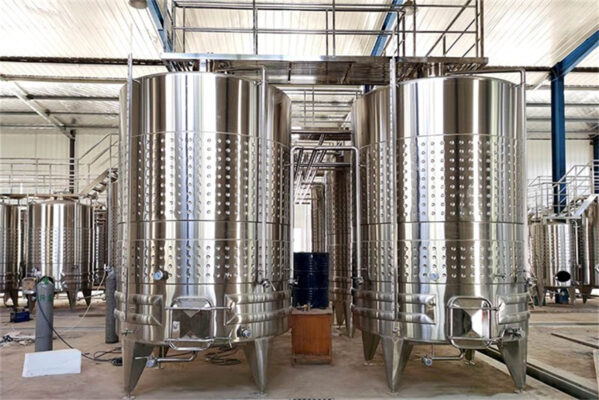
Ausrüstung zum Brauen von Alkohol Reinigung und Wartung
Um die Qualität der Anlagen und Produkte aufrechtzuerhalten, befolgen Brauereien zwischen den Chargen strenge Reinigungsverfahren mithilfe von CIP-Systemen (Clean-in-Place).
| Methode | Funktion | Verwendete Chemikalien |
|---|---|---|
| Ätzwäsche | Entfernt organische Rückstände | Natriumhydroxid, Natriumhypochlorit |
| Säurewäsche | Beseitigt Kalk- und Mineralablagerungen | Salpeter-, Phosphor- oder Schwefelsäure |
| Sterilisation | Tötet Bakterien ab | Isopropanol, Wasserstoffperoxid, Ozon |
Tägliche und wöchentliche Wartungskontrollen stellen zudem den ordnungsgemäßen Betrieb sicher:
- Überprüfen Sie Tanks und Ventile auf Undichtigkeiten
- Stellen Sie sicher, dass Temperatursensoren und Automatisierungssysteme gut kalibriert sind
- Überprüfen Sie, ob der Rohrleitungs- und Pumpsystemfluss wie erwartet verläuft
- Überprüfen Sie Protokolle auf Analysetrends
- Testen Sie die Reinigungswirkung
Die Einhaltung bewährter Reinigungs- und Wartungspraktiken trägt dazu bei, dass Fermentationsanlagen über Jahre hinweg konstant Höchstleistung erbringen.
FAQ
| Frage | Antwort |
|---|---|
| Was ist die wichtigste Ausrüstung für die Gründung einer Mikrobrauerei? | Für das Brauen im kleinen Maßstab sind ein Braukessel, Fermentertanks mit Temperaturregelung und eine Abfülllinie die Schlüsselelemente. Getreidehandhabung und andere Automatisierung können später hinzugefügt werden, wenn die Produktion steigt. |
| Welche Faktoren sollte ich bei der Geräteaufteilung und dem Platzbedarf berücksichtigen? | Berücksichtigen Sie die Gerätegröße, den Produktionsablauf, die Ergonomie, die Belüftung, den Zugang zu Versorgungseinrichtungen und den Platz für eine Vergrößerung oder das Hinzufügen von Tanks. Lassen Sie sich bei der Gestaltung von einem Ausrüstungslieferanten oder Brauereiberater beraten. |
| Soll ich automatische oder manuelle Geräte wählen? | Automatisierte Sudhäuser vereinfachen den Betrieb von Großanlagen. Manuelle Systeme bieten Flexibilität und praktische Kontrolle für kleinere Handwerksbrauereien und sind gleichzeitig kostengünstiger. Bewerten Sie Kompromisse basierend auf Produktionszielen, Budget und Personalkapazitäten. |




